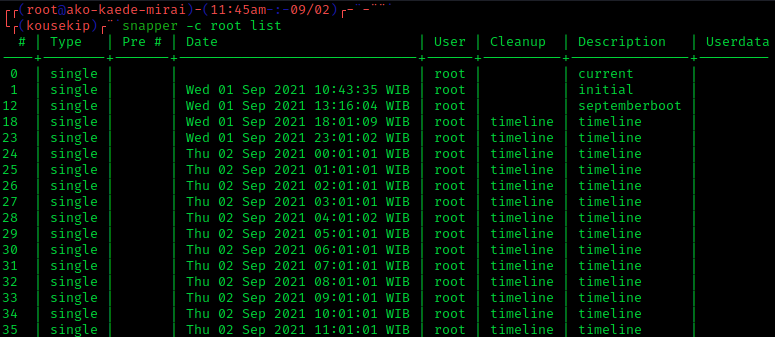|
Business Continuance Volume
In disk arrays, a business continuance volume (BCV) is EMC Corporation's term for an independently addressable copy of a data volume, that uses advanced mirroring technique for business continuity purposes. Use BCVs can be detached from the active data storage at a point in time and mounted on non-critical servers to facilitate offline backup or parallel computing. Once offline processes are completed, these BCVs can be either: * discarded * re-attached (re-synchronized) to the production data again * used as a source to recover the production data Types There are two types of BCVs: * A clone BCV is a traditional method, and uses one-to-one separate physical storage (splitable disk mirror) ** least impact on production performance ** high cost of the additional storage ** persistent usage * A snapshot BCV, that uses copy on write Copy-on-write (COW), sometimes referred to as implicit sharing or shadowing, is a resource-management technique used in computer programmin ... [...More Info...] [...Related Items...] OR: [Wikipedia] [Google] [Baidu] |
Disk Array
A disk array is a disk storage system which contains multiple disk drives. It is differentiated from a disk enclosure, in that an array has cache memory and advanced functionality, like RAID, deduplication, encryption and virtualization. Components of a disk array include: * Disk array controllers * Cache in form of both volatile random-access memory and non-volatile flash memory. * Disk enclosures for both magnetic rotational hard disk drives and electronic solid-state drives. * Power supplies Typically a disk array provides increased availability, resiliency, and maintainability by using additional redundant components (controllers, power supplies, fans, etc.), often up to the point where all single points of failure (SPOFs) are eliminated from the design. Additionally, disk array components are often hot-swappable. Traditionally disk arrays were divided into categories: * Network attached storage (NAS) arrays * Storage area network (SAN) arrays: ** Modular SAN arrays ** Mon ... [...More Info...] [...Related Items...] OR: [Wikipedia] [Google] [Baidu] |
EMC Corporation
Dell EMC (EMC Corporation until 2016) is an American multinational corporation headquartered in Hopkinton, Massachusetts and Round Rock, Texas, United States. Dell EMC sells data storage, information security, virtualization, analytics, cloud computing and other products and services that enable organizations to store, manage, protect, and analyze data. Dell EMC's target markets include large companies and small- and medium-sized businesses across various vertical markets. The company's stock (as EMC Corporation) was added to the New York Stock Exchange on April 6, 1986, and was also listed on the S&P 500 index. EMC was acquired by Dell in 2016; at that time, Forbes noted EMC's "focus on developing and selling data storage and data management hardware and software and convincing its customers to buy its products independent of their other IT buying decisions" based on "best-of-breed." It was later renamed to Dell EMC. Dell uses the EMC name with some of its products. Prior to ... [...More Info...] [...Related Items...] OR: [Wikipedia] [Google] [Baidu] |
Business Continuity
Business continuity may be defined as "the capability of an organization to continue the delivery of products or services at pre-defined acceptable levels following a disruptive incident", and business continuity planning (or business continuity and resiliency planning) is the process of creating systems of prevention and recovery to deal with potential threats to a company. In addition to prevention, the goal is to enable ongoing operations before and during execution of disaster recovery. Business continuity is the intended outcome of proper execution of both business continuity planning and disaster recovery. Several business continuity standards have been published by various standards bodies to assist in check listing ongoing planning tasks. An organization's resistance to failure is "the ability ... to withstand changes in its environment and still function". Often called resilience, it is a capability that enables organizations to either endure environmental changes withou ... [...More Info...] [...Related Items...] OR: [Wikipedia] [Google] [Baidu] |
Backup
In information technology, a backup, or data backup is a copy of computer data taken and stored elsewhere so that it may be used to restore the original after a data loss event. The verb form, referring to the process of doing so, is " back up", whereas the noun and adjective form is "backup". Backups can be used to recover data after its loss from data deletion or corruption, or to recover data from an earlier time. Backups provide a simple form of disaster recovery; however not all backup systems are able to reconstitute a computer system or other complex configuration such as a computer cluster, active directory server, or database server. A backup system contains at least one copy of all data considered worth saving. The data storage requirements can be large. An information repository model may be used to provide structure to this storage. There are different types of data storage devices used for copying backups of data that is already in secondary storage onto archi ... [...More Info...] [...Related Items...] OR: [Wikipedia] [Google] [Baidu] |
Parallel Computing
Parallel computing is a type of computation in which many calculations or processes are carried out simultaneously. Large problems can often be divided into smaller ones, which can then be solved at the same time. There are several different forms of parallel computing: bit-level, instruction-level, data, and task parallelism. Parallelism has long been employed in high-performance computing, but has gained broader interest due to the physical constraints preventing frequency scaling.S.V. Adve ''et al.'' (November 2008)"Parallel Computing Research at Illinois: The UPCRC Agenda" (PDF). Parallel@Illinois, University of Illinois at Urbana-Champaign. "The main techniques for these performance benefits—increased clock frequency and smarter but increasingly complex architectures—are now hitting the so-called power wall. The computer industry has accepted that future performance increases must largely come from increasing the number of processors (or cores) on a die, rather tha ... [...More Info...] [...Related Items...] OR: [Wikipedia] [Google] [Baidu] |
Disk Mirror
In data storage, disk mirroring is the replication of logical disk volumes onto separate physical hard disks in real time to ensure continuous availability. It is most commonly used in RAID 1. A mirrored volume is a complete logical representation of separate volume copies. In a disaster recovery context, mirroring data over long distance is referred to as storage replication. Depending on the technologies used, replication can be performed synchronously, asynchronously, semi-synchronously, or point-in-time. Replication is enabled via microcode on the disk array controller or via server software. It is typically a proprietary solution, not compatible between various data storage device vendors. Mirroring is typically only synchronous. Synchronous writing typically achieves a recovery point objective (RPO) of zero lost data. Asynchronous replication can achieve an RPO of just a few seconds while the remaining methodologies provide an RPO of a few minutes to perhaps several hou ... [...More Info...] [...Related Items...] OR: [Wikipedia] [Google] [Baidu] |
Snapshot (computer Storage)
In computer systems, a snapshot is the state of a system at a particular point in time. The term was coined as an analogy to that in photography. It can refer to an actual copy of the state of a system or to a capability provided by certain systems. Rationale A full backup of a large data set may take a long time to complete. On multi-tasking or multi-user systems, there may be writes to that data while it is being backed up. This prevents the backup from being atomic and introduces a version skew that may result in data corruption. For example, if a user moves a file into a directory that has already been backed up, then that file would be completely missing on the backup media, since the backup operation had already taken place before the addition of the file. Version skew may also cause corruption with files which change their size or contents underfoot while being read. One approach to safely backing up live data is to temporarily disable write access to data during th ... [...More Info...] [...Related Items...] OR: [Wikipedia] [Google] [Baidu] |
Copy On Write
Copy-on-write (COW), sometimes referred to as implicit sharing or shadowing, is a resource-management technique used in computer programming to efficiently implement a "duplicate" or "copy" operation on modifiable resources. If a resource is duplicated but not modified, it is not necessary to create a new resource; the resource can be shared between the copy and the original. Modifications must still create a copy, hence the technique: the copy operation is deferred until the first write. By sharing resources in this way, it is possible to significantly reduce the resource consumption of unmodified copies, while adding a small overhead to resource-modifying operations. In virtual memory management Copy-on-write finds its main use in sharing the virtual memory of operating system processes, in the implementation of the fork system call. Typically, the process does not modify any memory and immediately executes a new process, replacing the address space entirely. Thus, it would be ... [...More Info...] [...Related Items...] OR: [Wikipedia] [Google] [Baidu] |
Backup Software
Backup software are computer programs used to perform a backup; they create supplementary exact copies of files, databases or entire computers. These programs may later use the supplementary copies to restore the original contents in the event of data loss; hence, they are very useful to users. Key features There are several features of backup software that make it more effective in backing up data. Volumes Voluming allows the ability to compress and split backup data into separate parts for storage on smaller, removable media such as CDs. It was often used because CDs were easy to transport off-site and inexpensive compared to hard drives or servers. However, the recent increase in hard drive capacity and decrease in drive cost has made voluming a far less popular solution. The introduction of small, portable, durable USB drives, and the increase in broadband capacity has provided easier and more secure methods of transporting backup data off-site. Data compression ... [...More Info...] [...Related Items...] OR: [Wikipedia] [Google] [Baidu] |
Business Continuity
Business continuity may be defined as "the capability of an organization to continue the delivery of products or services at pre-defined acceptable levels following a disruptive incident", and business continuity planning (or business continuity and resiliency planning) is the process of creating systems of prevention and recovery to deal with potential threats to a company. In addition to prevention, the goal is to enable ongoing operations before and during execution of disaster recovery. Business continuity is the intended outcome of proper execution of both business continuity planning and disaster recovery. Several business continuity standards have been published by various standards bodies to assist in check listing ongoing planning tasks. An organization's resistance to failure is "the ability ... to withstand changes in its environment and still function". Often called resilience, it is a capability that enables organizations to either endure environmental changes withou ... [...More Info...] [...Related Items...] OR: [Wikipedia] [Google] [Baidu] |
Dell EMC
Dell EMC (EMC Corporation until 2016) is an American multinational corporation headquartered in Hopkinton, Massachusetts and Round Rock, Texas, United States. Dell EMC sells data storage, information security, virtualization, analytics, cloud computing and other products and services that enable organizations to store, manage, protect, and analyze data. Dell EMC's target markets include large companies and small- and medium-sized businesses across various vertical markets. The company's stock (as EMC Corporation) was added to the New York Stock Exchange on April 6, 1986, and was also listed on the S&P 500 index. EMC was acquired by Dell in 2016; at that time, Forbes noted EMC's "focus on developing and selling data storage and data management hardware and software and convincing its customers to buy its products independent of their other IT buying decisions" based on "best-of-breed." It was later renamed to Dell EMC. Dell uses the EMC name with some of its products. Prior to ... [...More Info...] [...Related Items...] OR: [Wikipedia] [Google] [Baidu] |

.jpg)



